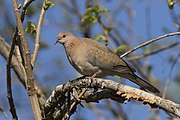Spilopelia
| Spilopelia | |
|---|---|

| |
| Spotted dove (S. chinensis) with plumage pattern of S. c. tigrina | |
| Scientific classification | |
| Domain: | Eukaryota |
| Kingdom: | Animalia |
| Phylum: | Chordata |
| Class: | Aves |
| Order: | Columbiformes |
| Family: | Columbidae |
| Subfamily: | Columbinae |
| Genus: | Spilopelia Sundevall, 1873 |
| Species | |
|
See text | |
| Synonyms | |
|
Stigmatopelia Sundevall, 1873 | |
Spilopelia is a genus of doves that are closely related to Streptopelia and Nesoenas, but distinguished from them by differences in morphology and genetics. Some authors[1] had argued that Stigmatopelia is the valid name as it appears in an earlier line of the same work by the Swedish zoologist Carl Sundevall,[2][a] but Richard Schodde and Ian J. Mason had earlier, in their 1999 zoological catalogue of Australian birds, chosen Spilopelia in treating these two names as applying to the same genus; their choice stands under clause 24(b) of the International Code of Zoological Nomenclature (ICZN) which supports the decision of the first reviser.[4][5] The name Spilopelia combines the Ancient Greek spilos meaning "spot" and peleia meaning "dove".[6]
| A phylogenetic position based on Johnson et al. (2001). A second possibility is that Columba is a sister of Streptopelia but the remaining clades appear to be monophyletic.[7] |
Species
The genus includes just two species:[8]
| Common name | Scientific name and subspecies | Range | Size and ecology | IUCN status and estimated population |
|---|---|---|---|---|
| Spotted dove | Spilopelia chinensis (Scopoli, 1786) Five subspecies
|
Indian subcontinent and in East and Southeast Asia | Size: 27–30 cm; 125–130 g Habitat: moist woodland, gardens Diet: seeds including grain, small fruit |
LC
|
| Laughing dove | Spilopelia senegalensis (Linnaeus, 1766) Five subspecies
|
Africa, the Middle East, South Asia | Size: 23–27 cm; 71–92 g Habitat: villages, gardens, dry woodland, savanna Diet: seeds including grain, small fruit, insects |
LC
|
Some ornithologists split the spotted dove into the eastern spotted dove (Spilopelia chinensis) and the western spotted dove (Spilopelia suratensis),[9][10] but this has not to date been accepted by the IOC.[11]
Notes
References
- ^ Cheke, Anthony S. (2005). "Naming segregates from the Columba–Streptopelia pigeons following DNA studies on phylogeny". Bulletin of the British Ornithologists' Club. 125 (4): 293–295.
- ^ Sundevall, Carl (1872). Methodi naturalis avium disponendarum tentamen. Försök till fogelklassens naturenliga uppställnung (in Latin). Stockholm: Samson and Wallin. p. 100.
- ^ Mathews, Gregory M. (1920). "Dates of ornithological works". Austral Avian Record. 4 (1): 1–27 [23].
- ^ Schodde, R.; Mason, I.J. (1997). Zoological Catalogue of Australia. Aves (Columbidae to Coraciidae). Vol. 37. CSIRO publishing. p. 20. ISBN 978-0-643-06037-1.
- ^ "Chapter 6: Validity of names and nomenclatural acts. Art. 24.2". International Code of Zoological Nomenclature (4th ed.). International Commission on Zoological Nomenclature. 1999.
- ^ Jobling, James A. (2010). The Helm Dictionary of Scientific Bird Names. London: Christopher Helm. p. 362. ISBN 978-1-4081-2501-4.
- ^ Johnson, K.P.; De Kort, S; Dinwoodey, K.; Mateman, A.C.; Ten Cate, C.; Lessells, C.M.; Clayton, D.H. (2001). "A molecular phylogeny of the dove genera Streptopelia and Columba" (PDF). Auk. 118 (4): 874–887. doi:10.1642/0004-8038(2001)118[0874:AMPOTD]2.0.CO;2. hdl:20.500.11755/a92515bb-c1c6-4c0e-ae9a-849936c41ca2.
- ^ Gill, Frank; Donsker, David; Rasmussen, Pamela, eds. (2020). "Pigeons". IOC World Bird List Version 10.1. International Ornithologists' Union. Retrieved 5 March 2020.
- ^ Baptista, L.F.; Trail, P.W.; Horblit, H.M.; Kirwan, G.M.; Garcia, E.F.J. (2020). del Hoyo, J.; Elliott, A.; Sargatal, J.; Christie, D.A.; de Juana, E. (eds.). "Eastern Spotted Dove (Spilopelia chinensis)". Handbook of the Birds of the World Alive. Lynx Edicions. doi:10.2173/bow.spodov.01. S2CID 216386337. Retrieved 7 March 2020.
- ^ del Hoyo, J.; Collar, N.; Kirwan, G.M.; Garcia, E.F.J. (2020). del Hoyo, J.; Elliott, A.; Sargatal, J.; Christie, D.A.; de Juana, E. (eds.). "Western Spotted Dove (Spilopelia suratensis)". Handbook of the Birds of the World Alive. Lynx Edicions. doi:10.2173/bow.spodov.01. S2CID 216386337. Retrieved 7 March 2020.
- ^ "Species Updates – IOC World Bird List". Retrieved 2024-08-09.



